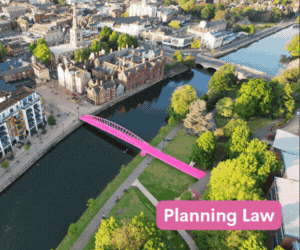Just what is it about today’s planning system that makes appealing so … appealing?
Simon Ricketts looks at the lessons from two recent recovered planning appeals, one of which saw a full award of costs against the council.
- Details
On 22 September 2025 the Secretary of State allowed two recovered appeals, granting planning permission for proposals which local authority members had refused against their professional officers’ opinions. In one of those cases, a full award of costs was ordered against the authority which I guess will amount to several hundred thousands of pounds. Development was unnecessarily held up in both cases for what turned out to be no good reason, in one case the decision to refuse having been in March 2024 following submission of the application in September 2022 and the other in May 2024 following submission of the application in November 2021. Both decisions were made in accordance with the relevant inspector’s recommendation.
I’m thinking back yet again to the Lichfields May 2025 research paper for the LPDF and Richborough Estates, How Long Is A Piece Of String? which found not only that applications for major development are taking twice as long to determine as 10 years ago but that it is now on average quicker to achieve permission via appeal than via the local planning authority.
I’m also thinking of the latest 50 Shades of Planning podcast episode Who’s In Control? (27 September 2025) where a number of us discuss, amongst other things, the ethical position of officers whose advice is overturned by councillors.
And I’m thinking that neither the proposed move to an increased number of applications being determined by way of delegated powers, and increased training for members, would have been likely to change the position with these two appeals. Do awards of costs influence behaviour? I would welcome your views. From the outside I’m not sure they really register either with councillors or, perhaps most importantly, with voters.
The two decisions were as follows:
Brighton Gasworks
Planning application submitted to Brighton and Hove Council in November 2021 by St William for a scheme that, following amendments, included 495 residential units and 2,791 square metres of commercial space. It was recommended for approval in May 2024 but in the face of significant local opposition was resolved to be refused. The reasons for refusal (1) alleged the development would represent overdevelopment of the appeal site by virtue of excessive massing, density and height thereby harming the townscape of the area including its heritage assets; (2) related to the proposed housing mix (subsequently withdrawn) and (3) concerned the effect of the appeal scheme on the living conditions of future residents with particular regard to amenity and light.
St William appealed. The appeal was recovered by the Secretary of State. The inquiry sat for six days in March 2025. The Secretary of State’s decision letter accepted the inspector’s recommendations and allowed the appeal. The Secretary of State’s conclusions are worthy of note on issues such as character and appearance, density and height (paragraph 14); the current negative effect of the “underused and despoiled” site on the “varied and robust urban townscape of east Brighton” (paragraph 15); daylight and sunlight and living conditions more generally (paragraphs 24 to 28); and acceptance of the agreed position between the appellant and the council that the development would not be able to provide affordable housing given the high cost of remediating the site (paragraph 30).
In his accompanying costs decision letter, again accepting his inspector’s recommendation, he orders a full award of costs in favour of St William, on the basis that:
- the Council prevented or delayed development which should clearly be permitted, having regard to its accordance with the development plan, national policy and all other material considerations (CR48);
- the Council failed to produce evidence to substantiate each reason for refusal on appeal, made vague, generalised or inaccurate assertions about a proposal’s impact and failed to determine similar cases in a consistent manner (CR49); and
- there were substantial procedural failings on the Council’s part including an obstructive and untimely approach to the Statement of Common Ground, the submission of a Statement of Case which was bereft of meaningful detail and a failure to review.
When it comes to any councillor training programme I hope this appeal decision will be part of the study materials, including, verbatim, these conclusions from the inspector’s costs report:
“Had the Council had proper regard to its own Development Plan, the NPPF, other material considerations and carried out a proper balancing exercise, the application would most likely have been approved notwithstanding the concerns raised by Members. The Council therefore prevented or delayed development which should clearly be permitted, having regard to its accordance with the development plan, national policy and all other material considerations.
The Council’s objections did not stand up to scrutiny and therefore I find that the Council failed to produce evidence to substantiate each reason for refusal on appeal, made vague, generalised or inaccurate assertions about a proposal’s impact and failed to determine similar cases in a consistent manner. It goes without saying that a decision to refuse planning permission on an allocated site against the professional advice of officers requires very careful consideration and highly robust reasoning.
There were also substantial procedural failings on the Council’s part including an obstructive and untimely approach to the SoCG, the submission of a Statement of Case which was bereft of meaningful detail and a failure to review its case promptly following a material change in national policy.
The above unreasonable behaviour resulted in unnecessary or wasted expense, as described in the PPG. I therefore conclude that a full award of costs is justified.
While I understand that the above will come as a bitter blow to the Council, it is right that I acknowledge the important work of officers during what was a long preapplication and determination period. That work culminated in the production of a Committee Report which was of the very highest order. Officers were also beyond reproach for the way they assisted the inquiry.”
Sky Studios Elstree expansion proposal
Planning application submitted in September 2022 for a film and television production studio (use Class E(g)(ii)) with ancillary floorspace, backlot, new access arrangements, car parking, landscaping, infrastructure and associated works in the green belt north of the existing Sky Studios Elstree complex. Hertsmere Borough Council members had resolved to refuse the application in March 2024 against officers’ recommendations, concluding that the “very special circumstances” test had not been made out for inappropriate development in the green belt.
Sky Studios appealed in October 2024 and the appeal was recovered by the Secretary of State. The inquiry sat for four days in March and April 2025. The Secretary of State’s decision letter accepted the inspector’s recommendations and allowed the appeal. Following the introduction of the grey belt policy designation into the NPPF in December 2024, the Secretary of State found that the site was indeed grey belt. The only real issue was whether there was unmet need for the development, on which issue his findings were as follows:
“For the reasons given at IR14.20-IR14.23 and IR14.43, the Secretary of State agrees with the Inspector that Sky Studios Limited has identified a need to enlarge its current operation at SSE, that there is a reasonable and probable outcome that if the appeal is allowed, the type of development that would take place would be for an extension of the existing studio site at SSE, and that there is an unmet need for studio space related directly to the expansion of SSE (IR14.23).
In reaching this conclusion, the Secretary of State has taken into account that the description of development does not specify that the development would be used as an extension to the existing SSE site, and no condition requiring the development to be an extension has been put forward either (IR14.17). He acknowledges that it is conceivable that the proposed development could be operated as a standalone studio business separate to SSE without any restrictions imposed by the description and any planning conditions (IR14.19). However, taking into account the matters set out at IR14.20-14.23, the Secretary of State considers that the proposal is highly likely to be brought forward as an extension and that it is appropriate to proceed on this basis. He considers on that basis that unmet need has been demonstrated and carries substantial weight in favour of the proposal, and that the requirement in NPPF155(b) is met.
The Secretary of State has also considered what the need position would be on the basis of a standalone studio. He has noted the position set out at IR14.24-14.25, but like the Inspector considers that national and local economic policy seeking to grow the sector, and an increased spend in productions, do not in themselves equate to unmet need.”
“…if considered as a standalone studio, the Secretary of State considers that unmet need has not been demonstrated. On that basis, the requirement in NPPF155(b) would not be met, the proposal would therefore be inappropriate development in the Green Belt and very special circumstances would need to be demonstrated. As set out at paragraph 21 above, in that scenario the Secretary of State considers that the harm to the Green Belt in terms of inappropriateness, harm to openness and harm to purposes would have carried substantial weight. Although he has not proceeded on that basis, for the avoidance of doubt, he considers that the harm to the Green Belt and any other harm would be clearly outweighed by the benefits of the scheme such that very special circumstances would exist and development in the Green Belt would be justified.”
A textbook application of green belt principles. (Incidentally, in the unlikely event that you need a primer on grey belt I think you can still access a webinar I gave recently on that subject via Inside Housing – see here for more details).
Perhaps the outcome of the Sky Studios appeal only became obvious once we had the December 2024 NPPF but perhaps the big question for MHCLG should be, rather than further tweaks to law or policy, how to make sure that many more appeals like these two are not needed before the message gets through as to how the current legislation and policy framework is to be applied? Otherwise, whether through members’ overturns, or through non-determination appeals, schemes will be continuing to come before the Planning Inspectorate, with all the delay, expense and unnecessary risk thereby arising, that really should be determined appropriately at a local level. It’s reassuring that the appeal route is available but the relative attractiveness of that route versus waiting for a local outcome is not good in public policy terms – as I said at a breakfast discussion that we held at Town Legal recently alongside Shared Voice and Rupert Warren KC and attended by the interim chief planning inspector Rebecca Phillips (for which thanks for her participation), it’s the equivalent of people being unhappy with the service at their local GP and instead going straight to A&E…
Simon Ricketts is a partner at Town Legal. This article first appeared on his Simonicity blog.
Senior Lawyer - Contracts & Commercial
Lawyer - Property
Trust Solicitor (Employment & Contract Law)
Contracts & Procurement Lawyer
Locums
Poll









































